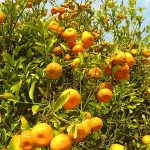
Introduction
Berry farming is capital intensive and export orientated. It is also labour intensive, and so has been championed as a crop of national interest by government for its employment and earner of foreign exchange potential.
Berries are sold as fresh produce, and so the post harvest process from the field to the customer plays a vital role. Prompt cooling after picking is important. The cold chain must be strictly applied, because any temperature variation will result in condensation of moisture on the fruit with subsequent increase in decay.
Handling requirements for berries differ and there is no way one set of handling requirements can be given. Suffice it to say that they are very delicate fruits and must be handled with the utmost care.
Berries are consumed as fruit, and also used as products for juice, jam, yoghurt preserves and liqueur.
Source: Trevor McKenzie
The Fresh Produce Exporters Forum (FPEF) in its Fresh Fruit Export Directory includes pomegranates and cherries along with blueberries and raspberries under the category “Exotic fruit”. Although there are references to pomegranate role players, mostly this page deals with berries. Readers are directed to the Pomegranate Association of South Africa (POMASA) (details under the “Role players” heading) and its website www.sapomegranate.co.za for information on pomegranates.
Contents
International business environment
Read the latest Fresh Plaza overviews of the global market for the different berries and exotic fruit at www.freshplaza.com.
Further reference:
- International Blueberry Organisation, www.internationalblueberry.org Find the 2022 Global State of the Blueberry Industry Report on the website.
- On the internet, find US Department of Agriculture (USDA) reports like “Blueberries Around the Globe – Past, Present, and Future” (2021, October 21).
- www.pickyourown.org – where you can find a pick-your-own farm near you (USA website but covers other countries)
- www.raspberries.us – an extensive source of information on raspberries
South Africa: imports and exports
As berries are largely an export crop, challenges include applying the cold chain, the cost of freight and competition from South America. Historically, most berry exports go to the United Kingdom and Europe. Improving market access to the Far East remains a priority.
There are two reasons why South Africa is well-placed to tap into the Northern Hemisphere markets:
- We have a range of climates suitable for berry-growing.
- We have a strategic advantage in the fact that we are out of season.
The export performance of blueberries, in line with production growth, has increased by around 37% per annum since 2011. Total exports are expected to reach around 42 000 tonnes by 2031, valued at a real (2020) CIF level of R3.1 billion (BFAP, 2022).
In 2019 the Netherlands, the “gateway into Europe” overtook the United Kingdom as the biggest importer of South African blueberries. There is also growing demand in some emerging markets, but it is not clear how the latter will respond to the current economic climate and high inflation levels. The market in developed countries is expected to be less affected as blueberries are more of a niche product that other fresh fruit (BFAP, 2022).
The exporting of fruit is subject to compliance with certain quality requirements and obtaining a Perishable Products Export Control Board (PPECB) export certificate. Find more information about berry exports in the Fresh Produce Exporters Forum (FPEF)‘s latest Export Directory and in the annual Food Trade SA publication from PPECB (see “Websites & publications” heading).
Local business environment
Find the BFAP South African Blueberry Outlook: 2023-2032 at www.bfap.co.za/south-african-blueberry-outlook-2023-2032
Statistics from BerriesZA suggest that blueberries are the largest cultivated berry in the country. They have also been the fastest growing fruit industry in South Africa. In the past decade, blueberry production increased on average by 32% per annum, the area planted expanding from 350 hectares in 2001, to 400 hectares in 2011, to 2 500 hectares in 2021. Production was estimated at around 27 000 tonnes in 2021 (BFAP, 2022).
Local consumption has grown from an estimated 314 tonnes in 2012 to around 3 200 tonnes in 2021. Demand has remained steady even with increased production.
Around 72% of the total harvest is exported, 12% goes to the country’s fresh market and the remaining 16% is sold for processing.
Negatives recently have been difficult weather conditions, challenges related to South Africa’s ports, and price pressure from Peruvian blueberries entering South Africa’s traditional export markets. Strong cost inflation and price declines are expected to lead to a slow down in the strong growth observed in the past decade.
Source: Bureau for Food & Agricultural Policy (BFAP) Baselines 2022-2031, 2021-2030
National strategy and government contact
Find details of the following directorates on the Department of Agriculture, Land Reform and Rural Development (DALRRD) website, www.dalrrd.gov.za :
- Directorate: Plant Health
- Directorate: Food Safety and Quality Assurance
- Directorate: International Trade
The Western Cape Department of Agriculture has the Alternative Crops Fund (ACF) – R3 million per annum – to boost exports and bolster land reform. Alternative, smaller crops include berries and pomegranates. These crops have high market value and are export-orientated. Alternative crops are mostly water smart and would therefore be preferred crops against the current, and most probable, dryer and even continued drought conditions in the Western Cape and the rest of South Africa. Promoting alternative crops is also one of the proposed actions of the SmartAgri plan. See www.elsenburg.com.
Role players
Further reference:
Finance
- Find further bodies on the “Finance for new farmers and SMMEs” and “Providers of financial services” pages.
Companies and growers
- The annual Fresh Produce Exporters Forum (FPEF) directory gives details of companies which export berries and exotic fruit. Find it at https://fpef.co.za.
- Several of the farms listed above supply berries as fresh fruit and value adds like berry jam … but also have offerings like group/school visits, accommodation, spas and events like a Raspberry Festival!
Websites and publications
Refer to websites listed earlier on this page.
- The exotic fruit category of the Fresh Produce Exporters Forum (FPEF) export directory covers blueberries, raspberries and pomegranates. Download the latest one at https://fpef.co.za.
- The annual Food Trade SA publication from PPECB can be read at https://ppecb.com/documents.
- The Abstract of Agricultural Statistics on www.dalrrd.gov.za , website of the Department of Agriculture, Land Reform and Rural Development, includes information on “Strawberries and other berries: Production, gross value, sales on markets and purchases for processing”. There is a grower guide for strawberries under “Brochures and production guidelines”. Find also the annual Statistics on fresh produce markets, which gives an exposition of the mass, value and unit value of the sales of fruit at each of the national fresh produce markets, month by month. Find the publications under the “Resource Centre” option.
- Call 012 842 4017 or email iaeinfo [at] arc.agric.za for the following publications, available from the ARC-Agricultural Engineering: (i) Agro-processing of Berries, Volume 1 (Blackberries; Blackcurrent; Blueberries; Cape Gooseberries; Cherries) (ii) Agro-processing of Berries, Volume 2 (Gooseberries; Raspberries; Redcurrants; Strawberries).
- CD Roms from the ARC-Plant Health and Protection (PHP) include: Crop Pests, vol. 1: Deciduous Fruit, Grapes and Berries. Write to booksales [at] arc.agric.za or infopri [at] arc.agric.za.
- Consult the AgriSETA Learner Guide Primary Agriculture “Harvesting agricultural crops“.
- Strawberry, raspberry, blackberry and blueberry are dealt with in the publication “Fruit and nut production in KZN”, which can be downloaded on the KZN Department of Agriculture website at www.kzndard.gov.za.
- Find the guides for growing strawberries, blueberries and other berries at www.growveg.co.za.
- Find the strawberry grower guide on the Haifa website at www.haifa-group.com.
- Download the Afrikaans grower guide on blueberries at www.saberries.co.za/landbou-weekblad-wil-jy-bloubessies-plant/.
Some articles
- Botha L. 2022, December 26. “A guide to optimising blueberry production”. Farmer’s Weekly. Available at www.farmersweekly.co.za/crops/fruit-and-nuts/a-guide-to-optimising-blueberry-production/
- Kriel G. 2022, November 3. “Pomegranate: a superfood that thrives in the Klein Karoo”. Farmer’s Weekly. Available at www.farmersweekly.co.za/crops/fruit-and-nuts/pomegranate-a-superfood-that-thrives-in-the-klein-karoo/
- Botha L. 2022, May 25. “Farmers losing farms as price of blueberries falls”. Farmer’s Weekly. Available at www.farmersweekly.co.za/agri-news/south-africa/farmers-losing-farms-as-price-of-blueberries-falls/
- Kriel G. 2022, January 13. “Robot boosts blueberry picking efficiencies”. Farmer’s Weekly. Available at www.farmersweekly.co.za/crops/field-crops/robot-boosts-blueberry-picking-efficiencies/
- Jones L. 2021, November 30. “Blueberry industry is the fastest-growing horticultural industry in South Africa”. FreshPlaza. Available at www.freshplaza.com/article/9378542/blueberry-industry-is-the-fastest-growing-horticultural-industry-in-south-africa/
- Marketplace Africa. 2021, September 21. “Blueberries could be the next cash crop in South Africa”. CNN. Available at https://edition.cnn.com/videos/business/2021/09/21/marketplace-africa-western-cape-blueberries-spc.cnn/video/playlists/marketplace-africa-pre-roll/
- Van der Walt J. 2021, May 27. “SA’s blueberry exports set to increase 58% this season”. Farmer’s Weekly. Available at www.farmersweekly.co.za/agri-news/south-africa/sas-blueberry-exports-set-to-increase-58-this-season/
- Liedtke S. 2021, January 28. “€3m loan to support South African blueberry industry”. Engineering News. Available at www.engineeringnews.co.za/article/3m-loan-to-support-south-african-blueberry-industry-2021-01-28
- AFP. 2020, December 2. “Demand for S. African ‘superfood’ blueberries booming”. MSN. Available at www.msn.com/en-za/news/world/demand-for-safrican-superfood-blueberries-booming/ar-BB1bxWmN
- Jansen C. 2020, November 18. “Blueberry grower alleges United Exports claimed royalties on unregistered varieties”. FreshPlaza. Available at www.freshplaza.com/article/9269470/blueberry-grower-alleges-united-exports-claimed-royalties-on-unregistered-varieties
- Githathu M. 2020, November 9. “Blueberry industry faces blues over trading rights row”. Cape Argus. Available at www.iol.co.za/capeargus/news/blueberry-industry-faces-blues-over-trading-rights-row-8017179e-251f-4e42-a80c-ce14ba44768c
- Kriel G. 2020, July 6. “The importance of timing to strawberry production”. Farmer’s Weekly. Available at www.farmersweekly.co.za/crops/fruit-nuts/the-importance-of-timing-to-strawberry-production/
- Read the US Department of Agriculture (USDA) report “South African Blueberry Industry Continues Strong Growth” (June 30, 2020).
- Bulbulia T. 2020, April 29. “South Africa’s blueberry production soars, strong future growth predicted”. Engineering News. Available at www.engineeringnews.co.za/article/south-africas-blueberry-production-soars-strong-future-growth-predicted-2020-04-29
- Mudge J. 2020, April 8. “South African blueberry boom continues with 53% increase in exports”. Fresh Plaza. Available at www.freshplaza.com/article/9206949/south-african-blueberry-boom-continues-with-53-increase-in-exports/
- Reporter. 2019, November 22. “South Africa berry production set to grow 80%”. Fresh Plaza. Available at www.freshplaza.com/article/9166253/south-africa-berry-production-set-to-grow-80/
- Kotzé J. 2019, October 10. “Blueberries: Market access a key ingredient for agricultural sector growth”. IOL. Available at www.iol.co.za/business-report/opinion/blueberries-market-access-a-key-ingredient-for-agricultural-sector-growth-34493553
- Liedtke S. 2019, August 22. “South African blueberry industry sets its sights on key export markets”. Engineering News. Available at www.engineeringnews.co.za/article/south-african-blueberry-industry-sets-its-sights-on-key-export-markets-2019-08-22
- The Money Show. 2019, August 22. “Blueberry production – and employment – skyrockets to all-time high”. 702. Available at www.702.co.za/articles/358583/blueberry-production-and-employment-skyrockets-to-all-time-high
- Sihlobo W. 2019, July 20. “Blueberries and Jobs in South Africa”. Available at https://wandilesihlobo.com/2019/07/20/blueberries-and-jobs-in-south-africa/
- IANS. 2019, June 3. “Eating blueberries can improve heart health”. IOL. Available at www.iol.co.za/lifestyle/health/eating-blueberries-can-improve-heart-health-24857614
- Spritzler F. 2019, April 24. “11 Reasons Why Berries Are Among the Healthiest Foods on Earth”. Healthline. Available at www.healthline.com/nutrition/11-reasons-to-eat-berries
- Jansen C. 2018, October 2. “South African blueberry industry aims to compete with Chile and Argentina”. FreshPlaza. Available at www.freshplaza.com/article/9028108/south-african-blueberry-industry-aims-to-compete-with-chile-and-argentina/
- Takadi K. 2018, August 3. “Blueberry production: big profits, big opportunities”. Farmer’s Weekly. Available at www.absa.co.za/content/dam/south-africa/absa/pdf/business/sector-focus/agribusiness/blueberry-production.pdf
- Janzen C. 2018, July 2. “South African blueberry production aims to close local supply gap”. Fresh Plaza. Available at www.freshplaza.com/article/197497/South-African-blueberry-production-aims-to-close-local-supply-gap
- Ferreira J. 2017, October 20. “Strawberries: overcoming the stumbling blocks”. Farmer’s Weekly. Available at www.farmersweekly.co.za/crops/fruit-nuts/strawberries-overcoming-stumbling-blocks/
- Find other articles on berries and exotic fruit in the Farmer’s Weekly and its website like “The complexity of berry farming” (which includes grower notes) and “A look at South Africa’s pomegranate production”. Visit www.farmersweekly.co.za.
- Slot S.B. 2017, June 6. “Quality Control challenges for blueberry exporters and retailers”. Fresh Plaza. Available at www.freshplaza.com/article/177008/Quality-Control-challenges-for-blueberry-exporters-and-retailers
- Find the article “Burgeoning South African dragon fly fruit industry” at www.freshplaza.com.
- Stander L. 2011, June 3. “Exporting berries to the UK has its own unique challenges”. How We Made It In Africa. Available at www.howwemadeitinafrica.com/exporting-berries-to-the-uk-has-its-own-unique-challenges/10090/



Share this article






